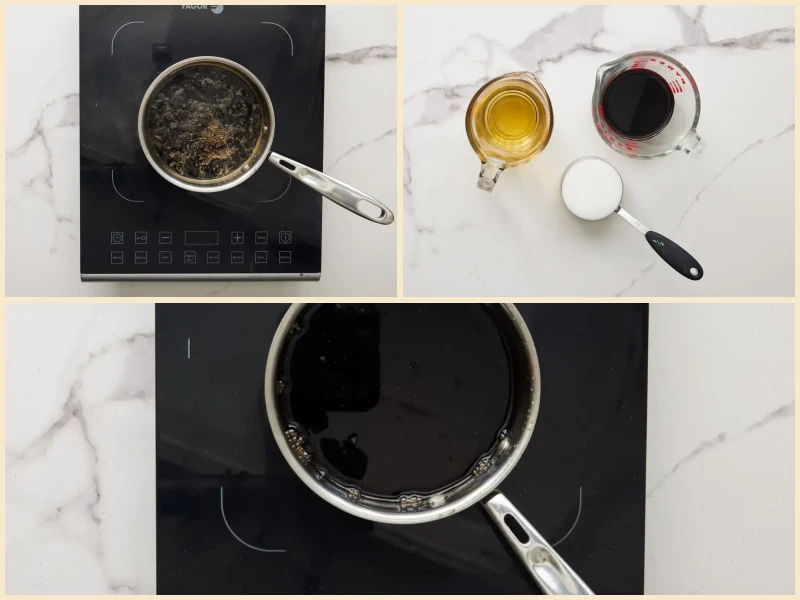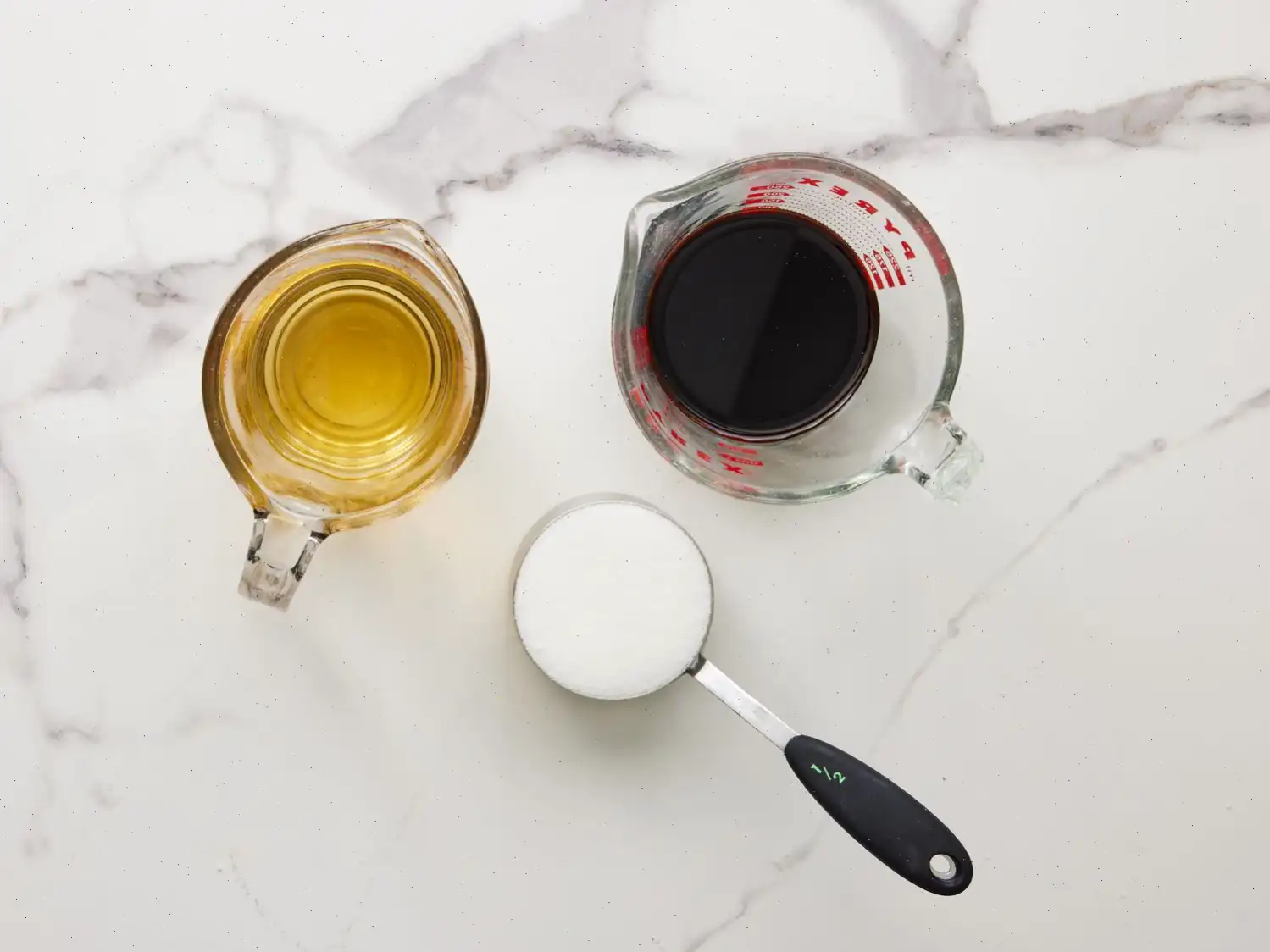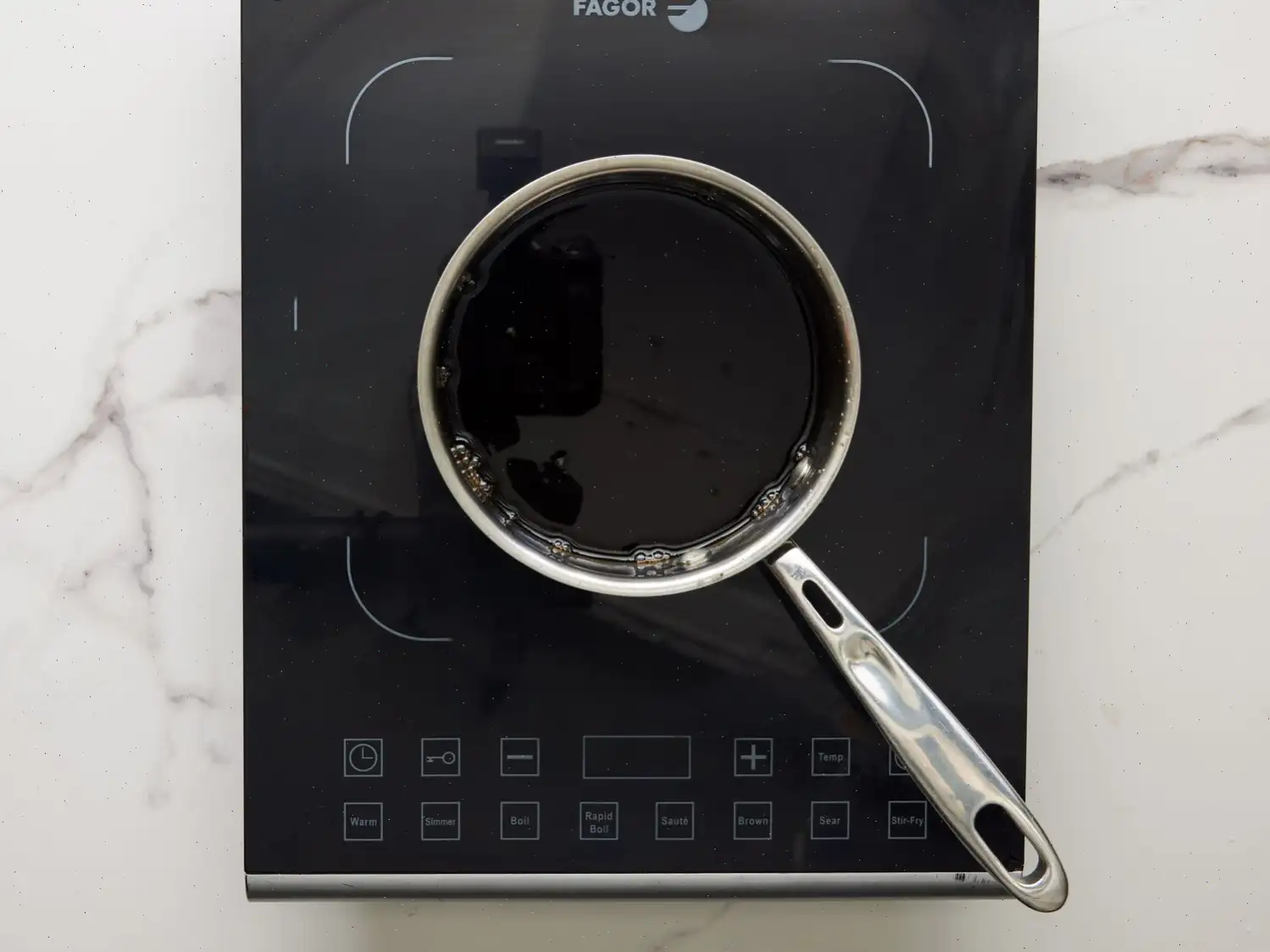
Eel Sauce Recipe
Ingredients
This recipe yields 6 servings. Ingredient amounts are adjusted automatically based on serving size, but cooking times and steps remain unchanged.
- cup soy sauce
- cup white sugar
- cup mirin (Japanese sweet wine)
Directions
- Gather all ingredients: soy sauce, sugar, and mirin.
- In a small saucepan, combine soy sauce, sugar, and mirin.
- Heat the mixture over medium heat, stirring occasionally.
- Continue cooking and stirring until the liquid has reduced to about cup.
Nutrition Facts
Per serving (6 servings total):
- Calories: 121
- Carbohydrates: 25g
- Protein: 1g
- Sodium: 1203mg (52% Daily Value)
- Total Sugars: 23g
- Dietary Fiber: 0g (1% Daily Value)
- Calcium: 6mg (0% Daily Value)
- Iron: 0mg (2% Daily Value)
- Potassium: 47mg (1% Daily Value)
* Percent Daily Values are based on a 2,000-calorie diet. Your daily values may vary depending on your calorie needs.
** Nutrient information is not available for all ingredients. Amounts are based on available nutrient data.
Note: If you follow a medically restrictive diet, please consult your doctor or registered dietitian before preparing this recipe for personal consumption.

History and Origins: Eel sauce, also known as "unagi no tare," is a sweet and savory condiment that has been an integral part of Japanese cuisine for centuries. Traditionally, it was created to accompany grilled eel dishes like unagi (freshwater eel) and anago (saltwater eel). The sauce is made by simmering soy sauce, mirin (a type of sweet rice wine), and sugar, resulting in a thick, glossy glaze that adds depth and richness to the flavor of eel. While it originated in Japan, eel sauce has become a popular addition to a variety of Japanese-inspired dishes around the world, especially in sushi bars and restaurants serving fusion cuisine.
Regional Variations: While the recipe for eel sauce remains largely consistent, there are subtle regional variations across Japan. In cities like Kyoto and Osaka, the sauce might be a little sweeter, as the region is known for its love of more delicately flavored, sweet dishes. On the other hand, in Tokyo, the sauce tends to be saltier and more savory, often balancing the sweetness of eel dishes. Some regions may also add small amounts of dashi (a Japanese broth) to the sauce to introduce an extra umami flavor, while others might use a different type of sweet rice wine depending on local availability.
How it Differs from Similar Sauces: Eel sauce may resemble other Asian sauces, such as teriyaki sauce or hoisin sauce, due to its sweet and savory profile. However, it is distinct in its use of mirin and its traditional pairing with eel. Teriyaki sauce typically has a higher proportion of soy sauce and sugar, and often includes garlic, ginger, or sesame oil, giving it a different flavor profile. Hoisin sauce, on the other hand, is more complex with flavors of five-spice, vinegar, and garlic, making it a better match for dishes like Peking duck. Eel sauce, in contrast, is relatively simple, focusing on the combination of soy sauce, sugar, and mirin for a sweet-salty flavor with less complexity.
Where It's Commonly Served: Eel sauce is most commonly served in Japanese restaurants, particularly with eel-based dishes such as unagi don (grilled eel over rice) or unagi nigiri (eel sushi). However, its versatility has made it a popular topping for other dishes such as tempura, grilled meats, and vegetables, and even as a dipping sauce for sushi rolls, particularly those that feature fried or grilled ingredients. Outside of Japan, eel sauce is also often used in fusion dishes, such as in American-style sushi or as a glaze for grilled chicken or fish.
Interesting Facts: 1. Eel sauce is not actually made from eel! The name "unagi no tare" translates to "eel sauce," but the sauce itself is completely vegetarian, made from soy sauce, mirin, and sugar. 2. The sauce's popularity extends beyond Japan: It has become a staple in many sushi restaurants worldwide. In fact, in places like the United States, it's often used on sushi rolls that don't even contain eel. 3. Eel sauce is prized for its unique ability to balance sweetness with saltiness, which complements the delicate flavors of seafood and grilled meats. 4. While it was originally associated with eel dishes, modern versions of eel sauce have found their way into everything from fried chicken to poke bowls, thanks to its versatile flavor. 5. Some chefs experiment by adding garlic, ginger, or citrus zest to give their eel sauce a more personalized touch, resulting in unique versions of the classic glaze.
You can listen to this recipe in AI audio format. Simply click the play button below to listen to the content in a format that suits you best. It’s a great way to absorb information on the go!
FAQ about Eel Sauce Recipe
Comments
Ashley Schulte
10/06/2025 01:52:54 PM
This was good. I like the eel sauce at my local sushi bar, it is thicker than this recipe, so I added 2 tablespoons of cornstarch to thicken it up a bit. It was perfect.
Jenny
05/24/2010 03:37:21 PM
I took some of the suggestions from other reviewers. I added 1/4 c. low sodium soy sauce, 1/4 c. reg. soy sauce, 1/2 c white sugar, 1/2 c. mirin, 1/4 tsp dashin, 1tsp corn starch. It turned out great!
RawWarrior
09/15/2015 06:42:32 PM
Tried it the way the recipe directed and was very good. Also made a batch with ~literally~ some BBQd Unagi blended in it with a bit of cornstarch. Then strained/squeezed through fine cloth. Amazing.
Tim Otey
07/17/2018 09:59:44 PM
So, I didnt have mirin, so I made that (1/2 cup sugar, 1/2 cup water, 4tsp rice vinegar, pinch salt) then used this recipie to make the sauce... simmered it a bit longer and got it thicker that way... turned out a touch sweet, but went great with the crab/cucumber/asparagus/cucumber rolls I made before I realized I was out of Unagi
staceysica
06/09/2018 12:04:38 AM
I cooked it on medium heat and let it boil for several minutes to cook down the liquid. It became foamy and started to smell like it was beginning to burn. It didn’t look or smell right. I started again-this time I let it just simmer, not boil, and cooked it for 45 minutes and it turned out perfect. Simmering is the key to a good result!
karcar68
12/22/2016 04:45:02 AM
Found that cornstarch isn't necessary to thicken as other reviewers noted...just let it cook long enough and it thickens up quite nicely -- and then more so as it cools. Fantastic flavor, made the poke bowls I used it in delicious!!
Love, April
02/09/2019 11:01:01 PM
I just made this, and it was delicious! I did not have mirin, so I used marsala instead. I also added some corn starch to thicken a bit. Came out just like my favorite sushi restaurant. I used this on Panko fried chicken. Delish!
FairUbe9226
04/14/2023 05:38:22 PM
I've just made this and it's really thick so I'm wondering if the people that said it was thin had the heat turned up enough? Mine was really bubbly and went a light shade of brown, once it cooled it was so thick I've had to add more soy sauce. Will try taste test tomorrow when I make sushi....
GlitzyZest5047
12/27/2023 02:19:46 AM
Made this tonight...absolutely delicious. Followed the recipe exactly and came out perfectly. Definitely needs to be allowed to thicken up while cooling...put it in the refrigerator and it is just the right consistency.
ToughTofu7391
06/19/2023 03:13:02 AM
Great simple tasty sauce. Too thin: You didn't cook it long enough. When it starts getting lots of bubbles, you are almost there. Too thick: You cooked it too long. It will thicken up more as it cools.
Heath
01/26/2017 02:47:58 AM
This turned out great! I didn't have any Japanese sweet wine so I used a Chardonnay I had in the fridge haha! It it will turned out pretty darn good. The reviewers that said it wasn't thick enough didn't let it cook long enough... you need to boil it until it's the texture you like!
Bubet
09/05/2025 03:26:38 AM
This recipe is so simple and delicious! I read the different additions that others have tried. They all sound so good, too! I will eventually try some variations, but for 3 ingredients and the simplicity of the instructions, I will make sure to have this made and ready all the time!
PestoSauco
03/04/2025 07:31:29 PM
Every time I looked for this sauce, I saw Eal and kept going. I finally looked at the recipe and realized how misleading the name is. I was very very pleased to discover how simple the recipe is and how much more flavorful than at the sushi place. Thank You!
AmberRoast8975
02/08/2025 07:46:18 PM
I love this sauce. I typically use Riesling instead of Mirin. Reduce it down and refrigerate. Even better after it sits! 🩷👩🏻🍳
SteadyDish2003
02/06/2025 01:51:52 AM
Good for two weeks?! Stop!! So good!!!!! I’m having it with a salad now. Wow. LET IT SIT! The longer it sits the better it tastes.
HandyMilk6468
11/25/2024 05:17:43 AM
Made this tonight to pair with some grocery store sushi and it was a winner!
Larry
09/15/2024 05:34:53 PM
Easy and terrific
Melissa Adams
08/17/2024 12:55:23 AM
Can’t believe it turned out so perfect.
Alexander Nelson
05/23/2024 10:20:18 PM
Quick, easy, and really flavorful.
TimidBun5617
12/31/2023 11:28:12 PM
Very simple, very tasty. Sprinkled some scallions for a finisher...love me some scallions! All in all a deceptively simple yet toothsome sauce.










